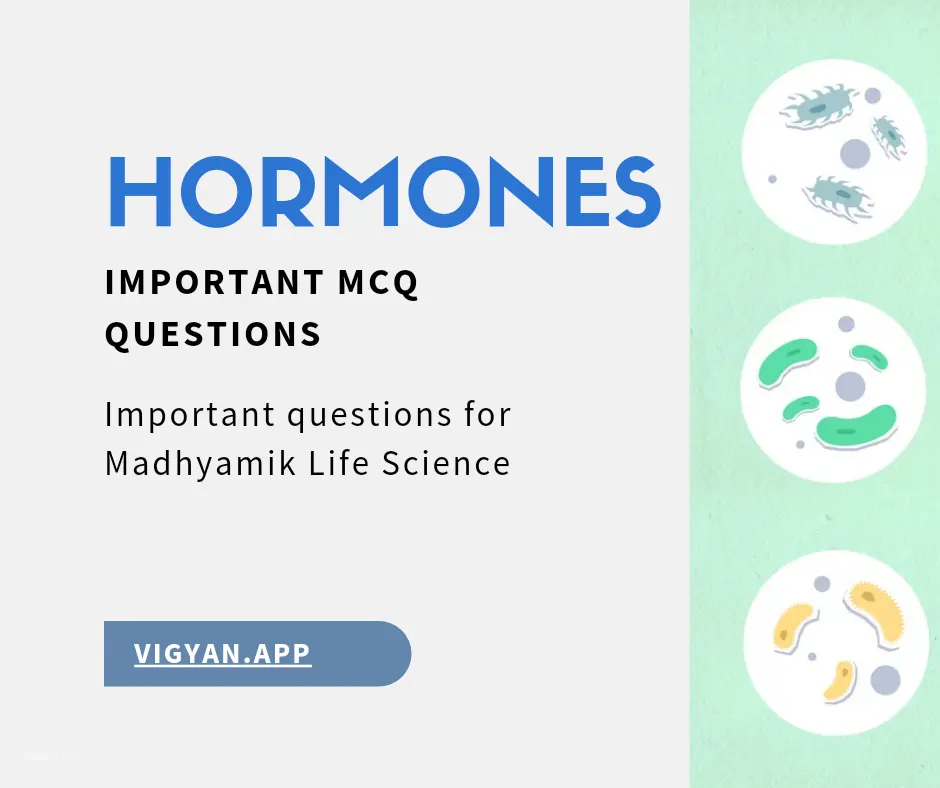Important Questions for Madhyamik Life science Adaptation (अनुकूलन)

बहुविकल्पिक प्रश्न (MCQ type qustions) :
दिए गए विकल्पों में से सही उत्तर को चिह्नित करें। (Tick the correct answer from the given options.)
1. जल में रहने वाले पौधे क्या कहलाते हैं। (Aquatic plants are known as):
(a) मिजोफाइट्स (Mesophytes)
(b) हाइड्रोफाइट्स (Hydrophytes)
(c) टेरिस्ट्रियल (Terrestrial)
(d) हैलोफाइट्स (Halophytes)
Ans. (b) हाइड्रोफाइट्स (Hydrophytes)
2. जड़ किसमे कम विकसित होते हैं। (Roots are ill developed in):
(a) जीरोफाइट्स में (In Xerophytes)
(b) हाइड्रोफाइट्स में (In Hydrophytes)
(c) हैलोफाइट्स में (In Halophytes)
(d) मिजोफाइट्स में (In Mesophytes)
Ans. (b) हाइड्रोफाइट्स में (In Hydrophytes)
3. किसकी ऊपरी सतह पर रंध्र होता है। (Stomata are present on the upper surface of)
(a) आम का पत्ता (Mango leaf)
(b) सुन्दरी का पत्ता (Sundri leaf)
(c) कैक्टस का पत्ता (Cactus leaf)
(d) कमल का पत्ता (Lotus leaf)
Ans. (d) कमल का पत्ता (Lotus leaf)
4. मरुभूमि में उगने वाले पौधे कहलाते हैं। (The desert plants are known as):
(a) जीरोफाइट्स (Xerophytes)
(b) हाइड्रोफाइट्स (Hydrophytes)
(c) टेरिस्ट्रियल (Terrestrial)
(d) हैलोफाइट्स (Halophytes)
Ans. (a) जीरोफाइट्स (Xerophytes)
5. निम्नलिखित में से टेंड्रिल किसके लिए अनुकूलित है। (Tendrlls are modifled for):
(a) दौड़ने के लिए (Running)
(b) चढ़ने के लिए (Climbing)
(c) चलने के लिए (Walking)
(d) इनमें से कोई नहीं (None of these)
Ans. (b) चढ़ने के लिए (Climbing)
6. किसमे तना मुलायम, छिद्रयुक्त तथा हवा से भरे होते हैं। (Stem are delicate, porous and filled wih air):
(a) जलीय पौधों में (In Hydrophytes)
(b) टेरिस्ट्रियल पौधों में (In terrestrial plants)
(c) मरुभूमिय पौधों में (In xerophytes)
(d) इनमें से कोई नहीं (None of these)
Ans. (a) जलीय पौधों में (In Hydrophytes)
7. किस तरह के पौधों में पत्तियाँ काँटों के रूप में परिवर्तित हैं। (Leaves are modified in spines);
(a) जीरोफाइट्स में (In xerophytes)
(b) हाइड्रोफाइट्स में (In Hydrophytes)
(c) मिजोफाइट्स में (In Mesophytes)
(d) हैलोफाइट्स में (In Halophytes)
Ans. (a) जीरोफाइट्स में (In xerophytes)
8. सुन्दरी कहाँ उगता है। (Sundari grows in ) :
(a) मीठे जल में (In fresh water)
(b) नमकीन मिट्टी में (In saline soil)
(c) मरूभूमि में (In desert)
(d) नदी में (In river)
Ans. (b) नमकीन मिट्टी में (In saline soil)
9. फाइलोक्लेड मांसल पत्ती नुमा रचना है। (Phylloclade is leaf like muscular structure of):
(a) तना का (of stem)
(b) जड़ का (of root)
(c) पत्ती का (of leaf)
(d) बीज का (of seed)
Ans. (a) तना का (of stem)
Suggestions for Madhyamik Pariksha
10. सुन्दरी किससे सम्बन्धित है। (Sundari is related with):
(a) जीरो फाइट्स से (Xerophytes)
(b) हैलोफाइट्स से (Halophytes)
(c) हाइड्रोफाइट्स से (Hydrophytes)
(d) इनमें से कोई नहीं (None of these)
Ans. (b) हैलोफाइट्स से (Halophytes)
11. सुन्दरी का पौधा कहाँ पाया जाता है। (Sundari plant is found )
(a) मीठे जल में (In soft water)
(b) नमकीन मिट्टी में (in saline soil)
(c) रेगिस्तान में (In deserts)
(d) खारे जल में (in saline water)
Ans. (b) नमकीन मिट्टी (In saline soil) में
12. किस पौधे में पत्तियाँ काँटे के रूप में रूपान्तरित हो जाती हैं? (In which plant leaves are modified into splnes?)
(a) जलीय पौधे (Hydrophytes)
(b) हैलोफाइट्स (Halophytes)
(c) जिरोफाइट्स (Xerophytes)
(d) किसी में नहीं (None of these)
Ans. (c) जिरोफाइट्स (Xerophytes)
13. जल संचय करने वाले ऊत्तक किसमे पाए जाते हैं। (Water storage tissues are found in) –
(a) नागफनी में (Cactus)
(b) मटर में (Pea)
(c) राइजोफोरा में (Rhizophora)
(d) किसी में नहीं (None of these)
Ans. (a) नागफनी में (Cactus)
14. वाताशय किसमे पाया जाता है। (Swim bladder is found in) –
(a) रोहू में (Rohu)
(b) कबूतर में (Pigeon)
(c) मनुष्य में (Man)
(d) सभी में (All of them)
Ans. (a) रोहू में (Rohu)
15. कैक्टस की पत्ती का काँटो में रूपान्तरित होने का कारण है। (The reason of modification of cactus leaf in spine is):
(a) प्रकाश संश्लेषन दर बढ़ना (Increase rate of photosynthesis)
(b) वाष्पोत्सर्जन का दर बढ़ना (Increase rate of Transpiration)
(c) वाष्पोत्सर्जन को रोकना (To check Transpiration)
(d) श्वसन का दर बढ़ाना (Increase rate of respiratiori)
Ans. (c) वाष्पोत्सर्जन को रोकना (To check Transpiration)
16. न्यूमैटोफोर कहाँ पाया जाता है । (Pneumatophores are found in ):
(a) कैक्टस में (In cactus)
(b) कमल में (In lotus)
(c) सुन्दरी में (In sundari)
(d) मटर पौधे में (In pea)
Ans. (c) सुन्दरी में (In sundari)
17. राइजोफोरा के बीज में किस प्रकार का अंकुरण पाया जाता है। (The nature of genrmination in Rhizophora seed is):
(a) हाइपोजियल (Hypogeal)
(b) इपिजियल (Epigeal)
(c) विविपैरी (Vivipary)
(d) कोई नहीं (None of these)
Ans. (c) विविपैरी (Vivipary)
18. किसके लिए पखने अनुकुलित होते हैं। (Fins are adapted for):
(a) वायवीय जीवन के लिए (Aerial life)
(b) जलीय जीवन के लिए (Aquatic life)
(c) रिस्ट्रियल जीवन के लिए (Terrestrial life)
(d) किसी के लिए नहीं (None of these)
Ans. (b) जलीय जीवन के लिए (Aquatic life)
19. भेलामेन क्या है। (Velamen is):
(a) जड़ (Root)
(b) पत्ती (Leaf)
(c) उत्तक (Tissue)
(d) तना (Stem)
Ans. (c) उत्तक (Tissue) है।
20. निम्नलिखित में से चमगदड़ क्या है। (Bat is):
(a) स्तनधारी (Mammal)
(b) पक्षी (Bird)
(c) टोड़ (Toad)
(d) ह्वेल (Whale)
Ans. (a) स्तनधारी (Mammal)
अनुरोध:- अगर आपको ये अच्छा लगा हो तो अपने दोस्तों को भी इसके बारे में बतायें ताकि वो भी इसका फायदा ले सकें । इस में अगर कोई गलती हो तो कमेंट करके जरुर बतायें, इसको सुधारने के बारे में आपका कोई भी सुझाव हो तो जरुर बतायें ताकि हम इसको और बेहतर कर सकें । धन्यवाद !
You May Also Like
- सामान्य विज्ञान से महत्वपूर्ण प्रश्नोत्तर
- सतत विकास और कृषि Sustainable development and Agriculture 1
- सजीवों में गति तथा प्रचलन का क्या उद्देश्य है Importance of movement and locomotion in living beings
- श्वसन, आक्सिक, अनॉक्सिक श्वसन Respiration, Aerobic and Anaerobic Respiration
- वैश्विक तापमान बढ़ने से भौंरे खतरे में Bumblebees in danger due to global warming
VIGYAN अब टेलीग्राम पर भी उपलब्ध है, नियमित अपडेट के लिए हमारे टेलीग्राम चैनल से जुड़ें
https://t.me/vigyanofficial


